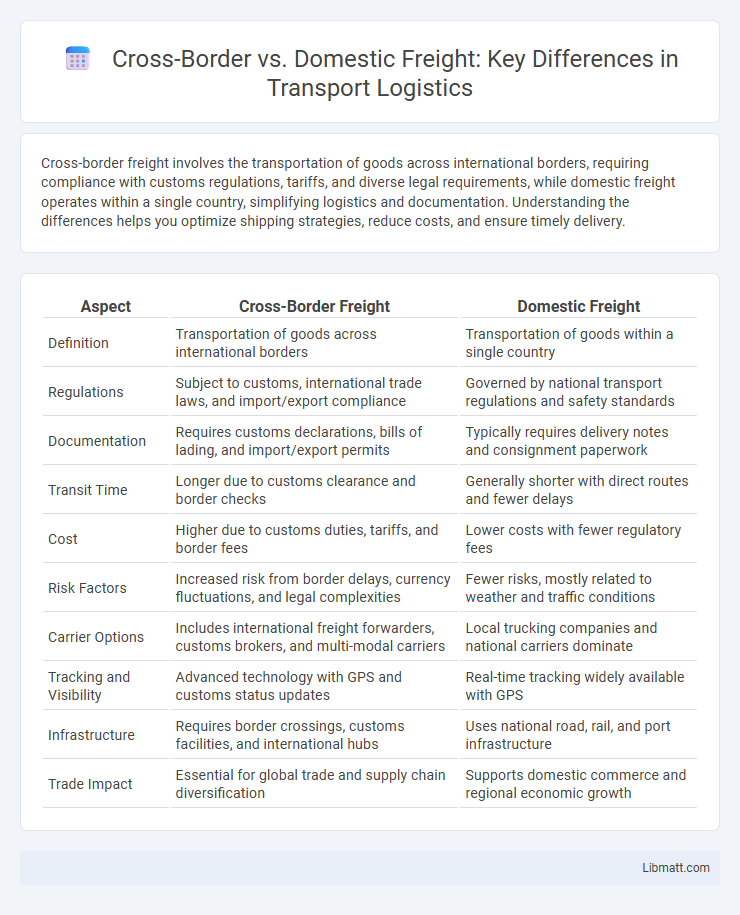Cross-border freight involves the transportation of goods across international borders, requiring compliance with customs regulations, tariffs, and diverse legal requirements, while domestic freight operates within a single country, simplifying logistics and documentation. Understanding the differences helps you optimize shipping strategies, reduce costs, and ensure timely delivery.
Table of Comparison
| Aspect | Cross-Border Freight | Domestic Freight |
|---|---|---|
| Definition | Transportation of goods across international borders | Transportation of goods within a single country |
| Regulations | Subject to customs, international trade laws, and import/export compliance | Governed by national transport regulations and safety standards |
| Documentation | Requires customs declarations, bills of lading, and import/export permits | Typically requires delivery notes and consignment paperwork |
| Transit Time | Longer due to customs clearance and border checks | Generally shorter with direct routes and fewer delays |
| Cost | Higher due to customs duties, tariffs, and border fees | Lower costs with fewer regulatory fees |
| Risk Factors | Increased risk from border delays, currency fluctuations, and legal complexities | Fewer risks, mostly related to weather and traffic conditions |
| Carrier Options | Includes international freight forwarders, customs brokers, and multi-modal carriers | Local trucking companies and national carriers dominate |
| Tracking and Visibility | Advanced technology with GPS and customs status updates | Real-time tracking widely available with GPS |
| Infrastructure | Requires border crossings, customs facilities, and international hubs | Uses national road, rail, and port infrastructure |
| Trade Impact | Essential for global trade and supply chain diversification | Supports domestic commerce and regional economic growth |
Introduction to Cross-Border and Domestic Freight
Cross-border freight involves the transportation of goods across international borders, requiring compliance with customs regulations, tariffs, and varying legal standards. Domestic freight, by contrast, refers to shipments conducted within a single country's boundaries, typically facing fewer regulatory hurdles and faster transit times. Efficient management of both freight types depends on understanding logistics requirements, documentation processes, and transportation modes unique to each context.
Key Differences Between Cross-Border and Domestic Freight
Cross-border freight involves transporting goods across international borders, requiring compliance with customs regulations, import/export documentation, and varying tariffs, unlike domestic freight which operates within a single country's boundaries with fewer regulatory hurdles. Transit times for cross-border freight tend to be longer due to inspections and clearance processes, whereas domestic freight typically offers faster delivery schedules. Your supply chain management must account for these distinctions to optimize shipping strategies and reduce potential delays.
Regulatory Requirements and Compliance
Cross-border freight involves complex regulatory requirements, including customs documentation, tariffs, and international trade laws, which differ significantly from domestic freight regulations. Compliance with import-export controls, security standards like C-TPAT or AEO, and varying country-specific safety protocols is essential to avoid delays and penalties. In contrast, domestic freight primarily adheres to national transportation laws, vehicle standards, and safety regulations, streamlining operational compliance within a single regulatory framework.
Cost Comparison: Cross-Border vs Domestic Freight
Cross-border freight typically incurs higher costs than domestic freight due to customs duties, tariffs, and compliance with international regulations, which add layers of complexity and expense. Domestic freight benefits from streamlined logistics, fewer regulatory hurdles, and lower handling fees, resulting in generally reduced transportation costs. Cost variability depends on factors such as distance, cargo type, and trade agreements affecting cross-border shipping fees versus domestic freight pricing.
Shipping Times and Transit Reliability
Cross-border freight typically experiences longer shipping times due to customs clearance processes and regulatory compliance, which can introduce delays compared to domestic freight. Transit reliability in cross-border shipping is often affected by varying national infrastructure quality and border control efficiency, leading to greater variability in delivery schedules. Domestic freight benefits from streamlined logistics and fewer regulatory hurdles, resulting in more consistent transit times and higher predictability.
Customs Procedures and Documentation
Cross-border freight requires comprehensive customs procedures and documentation, including import/export permits, customs declarations, and tariff classifications to comply with international trade laws. Domestic freight typically involves simpler documentation, such as bills of lading and delivery receipts, since it operates within a single country's regulations. Understanding these differences ensures your shipments clear customs efficiently and avoid costly delays or fines.
Logistics Challenges and Solutions
Cross-border freight involves navigating complex customs regulations, varied documentation requirements, and potential delays at international borders, unlike domestic freight which operates within a single regulatory environment. Solutions such as advanced tracking technologies, strategic partnerships with customs brokers, and comprehensive compliance management systems help mitigate these logistics challenges. Optimizing your supply chain with real-time data and streamlined cross-border procedures ensures smoother transit and reduces the risk of costly disruptions.
Technology and Tracking in Freight Shipping
Cross-border freight shipping utilizes advanced tracking technologies such as GPS, RFID, and blockchain to enhance transparency and real-time monitoring across multiple countries, ensuring your shipments comply with varying regulations. Domestic freight relies on integrated transportation management systems (TMS) and telematics for efficient route optimization and timely deliveries within a single country. Implementing the latest technologies in both cross-border and domestic freight improves operational efficiency, reduces delays, and strengthens supply chain visibility.
Choosing the Right Shipping Option for Your Business
Selecting the ideal shipping option depends on your business's specific needs, budget, and delivery timeline. Cross-border freight offers access to international markets but requires navigating customs regulations and potential delays, while domestic freight provides faster transit times and streamlined operations within your country. Understanding the trade-offs between cost, speed, and regulatory complexity ensures you optimize logistics and maintain supply chain efficiency.
Future Trends in Freight Transportation
Future trends in freight transportation emphasize the increasing integration of cross-border and domestic freight systems through advanced digital platforms, enabling real-time tracking and seamless customs processing. Autonomous vehicles and electric trucks are expected to revolutionize both domestic and international logistics by reducing costs and emissions. Growth in e-commerce continues to drive demand for faster, more flexible freight solutions, pushing innovations in last-mile delivery and multimodal transport networks.
cross-border vs domestic freight Infographic

 libmatt.com
libmatt.com